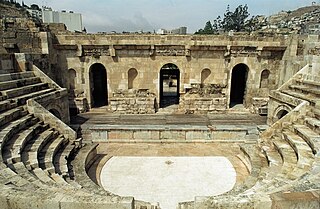
Amman is the capital and the largest city of Jordan, and the country's economic, political, and cultural center. With a population of 4,061,150 as of 2021, Amman is Jordan's primate city and is the largest city in the Levant region, the fifth-largest city in the Arab world, and the tenth-largest metropolitan area in the Middle East.

Aqaba is the only coastal city in Jordan and the largest and most populous city on the Gulf of Aqaba. Situated in southernmost Jordan, Aqaba is the administrative center of the Aqaba Governorate. The city had a population of 148,398 in 2015 and a land area of 375 square kilometres (144.8 sq mi). Today, Aqaba plays a major role in the development of the Jordanian economy, through the vibrant trade and tourism sectors. The Port of Aqaba also serves other countries in the region.

The Amman International Stadium is a stadium in Al-Hussein City, Amman, Jordan. It was built in 1964 and opened in 1968. It is owned by the Government of Jordan and operated by the Higher Council of Youth. It is also the home stadium of the Jordan national football team and Al-Faisaly SC. It has a current capacity of 17,619 spectators.
The King Abdullah II Stadium is a multi-purpose stadium located in Amman, Jordan. It is currently used mostly for football matches. The stadium holds 13,265 people.

Al-Khazneh, akaKhazneh el-Far'oun, is one of the most elaborate rock-cut tombs in Petra, a city of the Nabatean Kingdom inhabited by the Arabs in ancient times. As with most of the other buildings in this ancient town, including the Monastery, this structure was carved out of a sandstone rock face.

Mahis is a town in the Balqa Governorate northwest from the governorate's capital Salt, and 10 kilometers (6.2 mi) west of Amman. Its population was 17,754 in 2015. Most of the population of Mahis descends from the Abbadi tribe.. The mountainous town is located at over 800 meters (2,600 ft), with views on the Jordan Valley, West Bank with Jerusalem's walls visible on the horizon. Mahis is known for its orchards and its numerous water fountains and springs, notably the Fountain of Mahis.

Jordan is a sovereign Arab state in the Middle East. The capital, Amman, is Jordan's most populous city as well as the country's economic, political and cultural centre.

Rainbow Street, originally named Abu Bakr al Siddiq street, is a public space in the historic area of Jabal Amman, near the center of downtown Amman, Jordan.

Abdali is an area in the Greater Amman Municipality, Jordan. It is named relative to King Abdullah I who founded it during the 1940s. It covers an area of 15 square kilometres (6 sq mi) in the heart of Amman, with a population of 165,333 in 2015. Large parts of the district are residential, but due its geographical location in the center of the city, it contains several important governmental buildings and businesses. The area is known for containing several bus stations serving routes to many cities in Jordan. It contains the Jabal el-Hussein camp, a Palestinian refugee camp.

Basman is a district of the city of Amman, Jordan.

The Amman Citadel is an archeological site at the center of downtown Amman, the capital of Jordan. The L-shaped hill is one of the seven hills (jebal) that originally made up Amman.

The Le Royal, is one of the tallest buildings in Amman, Jordan. Located in the 3rd Circle area, the building serves as a host of Le Royal Hotel chain in addition to a shopping mall, cinemas and commercial offices. It is a major landmark in Amman and one of the tallest buildings in Amman.

Specialty Hospital is a community hospital in Amman, Jordan, established in 1993 under royal patronage. A 250-bed multispecialty equipped facility, it was the first hospital to attain the BS OHSAS 18001 certification and is also the owner of several other international and national accreditations and recognitions, such as MECC award, King Abdullah II award, HCAC accreditation, ISO 9002 and ISO 9001, and more.
The following is a timeline of the history of the city of Amman, Kingdom of Jordan.

Zara Investment Holding Co Ltd. was founded on 10 May 1994 by Sabih al-Masri, the current chairman, and Khalil Talhouni, in addition to a number of investors and local banks and Arab and international investment companies, such as the International Finance Corporation (IFC).

The Boulevard is a $300 million mixed-use development that is located in Abdali Project in Amman, Jordan. It consists of a pedestrian strip surrounded by twelve 6 floored buildings. Inaugurated in 2014 by King Abdullah II accompanied by Queen Rania.

The Odeon is a small 500-seat theatre in Amman, Jordan. Not to be confused with the large Roman Theatre that stands right next to it, on the southern side of the Hashemite Plaza, while the Odeon stands on the east side of the Plaza.

Jordan Folklore Museum is a museum in Amman, Jordan. It is located next to the Roman amphitheater, it was established in 1971. The museum showcases a collection of Jordanian cultural heritage items from the desert (Bedu), villages (Reef), and towns (Madineh) including; costumes, musical instrument and handicrafts. Along with mosaics.

Zahran is an area in the Greater Amman Municipality. It is named after the Zahran Palace which stands amidst Zahran street. It consists of 5 neighborhoods of which most parts are residential, however, some parts of the district contain Amman's best hotels, hospitals and towers. The district is also home to several governmental buildings, embassies, cultural centers and schools. Zahran area stretches from 1st circle to between 5th and 6th circles, and from North Abdoun to South Abdoun.


















